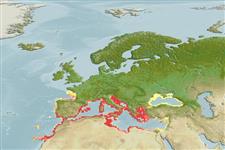>
Eupercaria/misc (Various families in series Eupercaria) >
Sparidae (Porgies)
Etymology: Diplodus: Greek, diploos = twice + Greek, odous = teeth (Ref. 45335).
More on author: Linnaeus.
Environment: milieu / climate zone / Mức độ sâu / distribution range
Sinh thái học
Biển; Thuộc về nước lợ Sống nổi và đáy; Mức độ sâu 0 - 90 m (Ref. 4781). Subtropical; 49°N - 27°N, 19°W - 42°E
Eastern Atlantic: Canary islands, also found along the coast of Portugal northward to the Bay of Biscay, Mediterranean, Black Sea and Sea of Azov (Ref. 4781).
Length at first maturity / Bộ gần gũi / Khối lượng (Trọng lượng) / Age
Chín muồi sinh dục: Lm 11.6, range 8 - 19.6 cm
Max length : 28.0 cm TL con đực/không giới tính; (Ref. 124816); common length : 13.0 cm TL con đực/không giới tính; (Ref. 3397); Khối lượng cực đại được công bố: 330.00 g (Ref. 115876); Tuổi cực đại được báo cáo: 17 các năm (Ref. 124518)
Các tia vây lưng cứng (tổng cộng) : 11; Các vây lưng mềm (tổng cộng) : 11 - 13; Tia cứng vây hậu môn: 3; Tia mềm vây hậu môn: 11 - 12.
Body shape (shape guide): fusiform / normal; Cross section: compressed.
Inhabit chiefly Zostera seagrass beds but also found on Posidonia beds and sandy bottoms, rarely on rocky bottoms. Carnivorous, feed on worms, crustaceans, mollusks, echinoderms and hydrozoans. The sexes are separated, although these fish are potential hermaphrodites; certain individuals are protandric (Ref. 4781).
Normally sexes are separate but some individuals are protandrous due to geographical variation in sexual pattern (Ref. 103751). However, histological studies confirm no degenerating functional tissue of one sex (e.g. vitellogenic or later-stage follicles) and no proliferation of tissue of the other sex can be found on this species indicating the absence of sex change. This particular condition is also known as nonfunctional hermaphroditism previously known as rudimentary hermaphroditism (Ref. 91314). Also Ref. 28504.
Bauchot, M.-L. and J.-C. Hureau, 1990. Sparidae. p. 790-812. In J.C. Quero, J.C. Hureau, C. Karrer, A. Post and L. Saldanha (eds.) Check-list of the fishes of the eastern tropical Atlantic (CLOFETA). JNICT, Lisbon; SEI, Paris; and UNESCO, Paris. Vol. 2. (Ref. 3688)
IUCN Red List Status (Ref. 130435: Version 2025-1)
Threat to humans
Harmless
Human uses
Các nghề cá: Tính thương mại; cá để chơi: đúng
Các công cụ
Special reports
Download XML
Các nguồn internet
Estimates based on models
Preferred temperature (Tài liệu tham khảo
123201): 14.8 - 21.1, mean 18.3 °C (based on 220 cells).
Phylogenetic diversity index (Tài liệu tham khảo
82804): PD
50 = 0.5000 [Uniqueness, from 0.5 = low to 2.0 = high].
Bayesian length-weight: a=0.01202 (0.01096 - 0.01319), b=3.07 (3.05 - 3.09), in cm total length, based on LWR estimates for this species (Ref.
93245).
Mức dinh dưỡng (Tài liệu tham khảo
69278): 3.6 ±0.0 se; based on diet studies.
Generation time: 4.5 (2.4 - 6.4) years. Estimated as median ln(3)/K based on 18
growth studies.
Thích nghi nhanh (Tài liệu tham khảo
120179): Trung bình, thời gian nhân đôi của chủng quần tối thiểu là 1.4 - 4.4 năm (K=0.2-0.5; tmax=7; Fecundity=18,000 - 212,000).
Prior r = 0.54, 95% CL = 0.35 - 0.80, Based on 3 full stock assessments.
Fishing Vulnerability (Ref.
59153): Moderate vulnerability (36 of 100).
🛈
Climate Vulnerability (Ref.
125649): Moderate vulnerability (36 of 100).
🛈
Nutrients (Ref.
124155): Calcium = 83.2 [48.2, 160.3] mg/100g; Iron = 0.984 [0.561, 1.738] mg/100g; Protein = 19.3 [18.4, 20.3] %; Omega3 = 0.427 [0.224, 0.818] g/100g; Selenium = 23.7 [11.6, 43.4] μg/100g; VitaminA = 20.1 [6.8, 55.9] μg/100g; Zinc = 1.06 [0.72, 1.48] mg/100g (wet weight);
